It's now available Ted's LightSpace CMS Calibration Disk for PGenerator, with 162 patterns of static or flashing bars.
Inject any pattern using Ted's Template of DeviceControl while calibrating with ColourSpace, ColourSpaceZRO, LightSpace, CalMAN, or HCFR.

Direct integration with ColourSpace or ColourSpaceZRO for pattern injection or settings/output adjustments using ColourSpace's GUI.
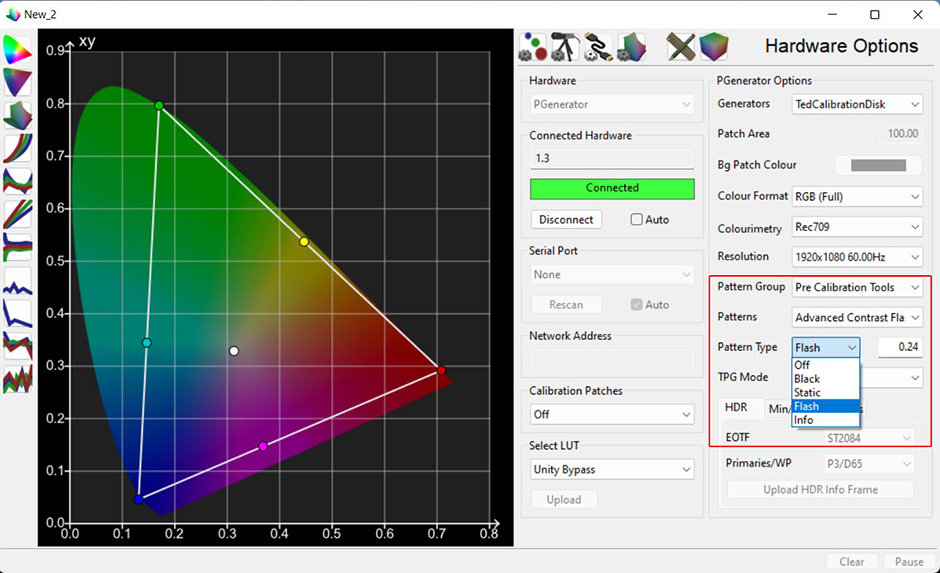

Ted's PGenerator patterns have better gradation (full chroma) without compression artifacts.
In contrast, the Blu-Ray or Media Files have reduced chroma due to YCbCr 4:2:0 compression.
According to BD authoring specifications, the SDR Blu-Rays or the Media Files use H.264 YCbCr 4:2:0 8-bit compression.
Ted's PGenerator has internally 8-bit RGB uncompressed patterns.
PGenerator with a Pi3 (or older) board can generate accurate patterns with RGB output colorspace.
PGenerator with a Pi4 board can accurately convert Ted's RGB patterns to YCbCr 4:4:4 (lossless compression) or generate them as RGB.
Pi4-boards have accurate YCbCr 4:4:4 or RGB colorspace output of Ted's Patterns.
Ted's PGenerator can convert the SDR patterns with static or flashing bars to HDR10, HLG, or Dolby Vision.
However, we recommend using only patterns for near-black evaluation with HDR10, HLG, or Dolby Vision conversion.
We highly recommend checking the levels and the output settings of all your sources using Ted's (Blu-Ray or Media Files) after the calibration using PGenerator or other hardware TPG.
Ted's PGenerator has Brightness patterns without numbers or text indicators.
The 'no text' patterns are more efficient with OLED/Projector than the 'text info' versions; however, both options are available.
Advanced Brightness Flashing Bars (Text Info Edition):
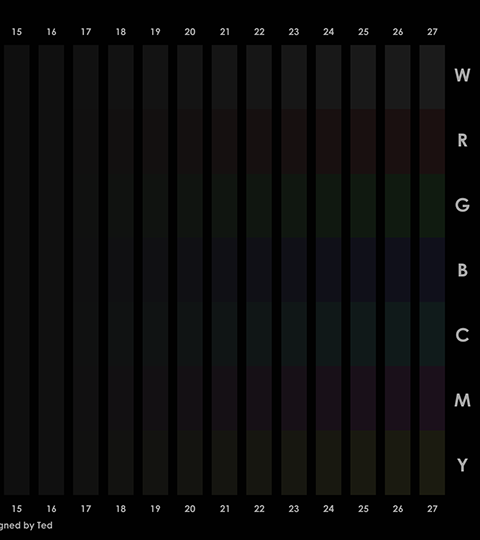
Advanced Brightness Flashing Bars (No Text Info Edition):
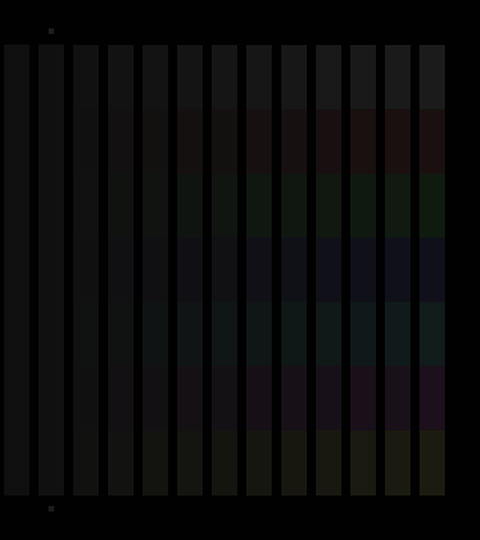
The small 10x10 pixel box at the top/bottom of the flashing bar works as an indicator for the Reference Black (16).
Quick Black Patch Injection overrides your calibration software patch and generates a black full-screen patch.
That function will help your panel to cool down and reduce heat after the end of your SDR or HDR measurements.
Inject a black pattern when not taking measurements; open your TV/PJ OSD menu for adjustments or check the measurements in your software.
Black patch injection is available to Ted's Template on the DeviceControl or in ColourSpace/ColourSpaceZRO GUI.
The Delay Flashing Pattern value allows the user to define the timing period of the patterns with flashing bars.
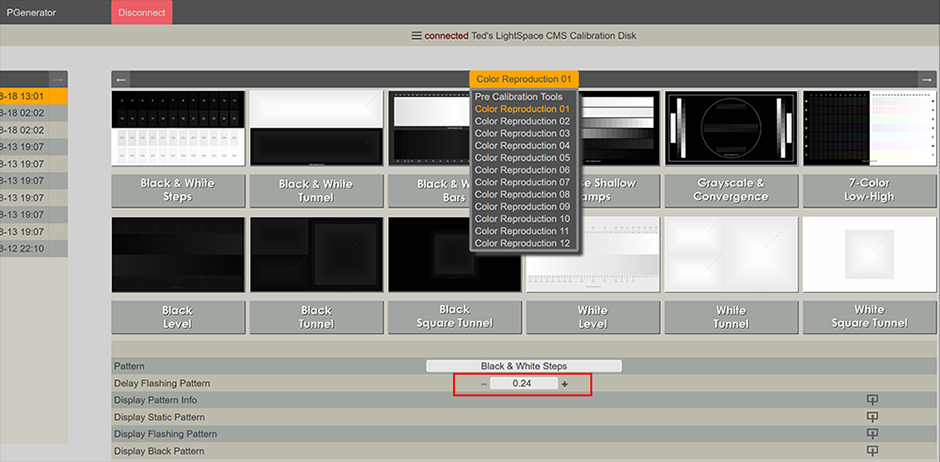
Using a 240 ms setting (the default), it will match the 1-sec interval flashing rate of the same pattern as available to the 24p video stream edition.
You can change that value using Ted's Template in DeviceControl or the ColourSpace/ColourSpaceZRO's GUI.
If required, you can generate a flashing pattern as a static one or stop the flashing animation.
Users can upload their custom 1080p or 2160p 8-bit patterns.
The upload function has no limitation on the number of uploaded patterns.
For example, a 16GB microSD card will have enough free space to upload about ~1000 TGA uncompressed images or some thousands of PNGs.
TGA image files are uncompressed, while PNGs are compressed but lossless.
BMP or TIFF image file formats are also supported.

You can upload your favorite reference movie stills for color evaluations or create custom patterns using your drawing software.

Full 8/10-bit RGB-triplet pattern generator for SDR, HDR10, HLG, and Dolby Vision using supported hardware and software.
Custom patch sizes, background color, or position of the patch window.
CalMAN supports 10% windows or full-field patches.
HCFR supports custom patch sizes.
ColourSpace, ColourSpaceZRO or LightSpace supports custom patch sizes, custom positioning, and custom background color.
Custom background color can help panels with aggressive backlight dimming or active local-dimming functions that can't be disabled during calibration.
Use a gray or white background color to provide more constant backlight dimming during the calibration.
White background with a 50% patch window will provide less panel drift during the calibration of high-brightness on-camera monitors.
Set a custom position of the patch window (top left, bottom right, etc.) for various panel tests; backlight bleeding, uniformity, contrast, etc.
LightSpace, CalMAN, or HCFR users can use each software GUI to define the patch size area.
LightSpace, CalMAN, or HCFR users can use Settings Template 1.3 in DeviceControl to change output settings and set the HDR10 InfoFrame or AVI parameters.
LightSpace, CalMAN, or HCFR users can inject Ted's Patterns using Ted's Template in DeviceControl.
ColourSpace or ColourSpaceZRO users can define size, position, the background color, change output settings, set the HDR10 InfoFrame or AVI parameters, and inject Ted's Patterns using ColourSpace's GUI.
Pi3 board (or older) with ColourSpace, ColourSpaceZRO, LightSpace, CalMAN or HCFR supports SDR with 8-bit RGB (REC.709) 1080p output.
Pi4 board with LightSpace, CalMAN, or HCFR supports SDR, HDR10, HLG with 8-bit RGB or YCbCr 4:4:4 (REC.709 or REC.2020) 2160p output.
Pi4 board with ColourSpace or ColourSpaceZRO supports SDR, HDR10, HLG and Dolby Vision* with 8-bit/10-bit RGB or YCbCr 4:4:4/4:2:2 (REC.709 or REC.2020) 2160p output. (* Dolby Vision HDMI Tunneling uses 8-bit RGB as a container.)
Dolby Vision TPG works with compatible TV-LED displays, like the LG OLEDs. You can disable the DV processing to calibrate the panel and re-enable it to verify the calibration.
LG OLEDs iTPG can't verify the DV calibration.
CalMAN Home for LG customers can use ColourSpace or ColourSpaceZRO to verify their DV AutoCAL calibration since the LGs iTPG can't verify the DV calibration.
Using our dedicated guide, you can perform a full LG OLED Dolby Vision calibration with ColourSpace or ColourSpaceZRO.
In addition, we have included a macro-enabled excel to auto-generate the Dolby Configuration file for your LG TV model (2017-2022).
Dolby's HDMI Tunnelling will require a TV-LED Dolby Vision HDMI-capable TV model.
We have tested the LG OLEDs 2017-2022, and DV TPG is working.
Starting from 2021, Sony OLED TVs support TV-LED Dolby Vision.
It may work with other TV-LED DV capable TV models, but we haven't yet tested Panasonic, Philips, or Sharp TVs.
It will work with TCL TV-LED DV capable TV models.
We can add a list with the supported TV models when we will have enough feedback from users of other TV-LED Dolby Vision capable TVs.

ColourSpace or ColourSpaceZRO customers of PGenerator can use 10-bit patchlists (input) and generate accurate 10-bit patches (output).
CalMAN or HCFR supports only 8-bit patchlists.
Murideo SEVEN (5K$) supports 10-bit input/output, like the PGenerator with a Pi4-board.
Murideo SiX G GEN1/GEN 2 (2.5K$), Six-G GEN 8K (3K$), or VideoForge PRO (1.5K$) are not supporting 10-bit (input).
However, they can provide 10-bit output using a conversion matrix (8-bit -> 10-bit), so they are not 'real' 10-bit TPGs.
You can see below the differences in grayscale patch generation, for example, in TV legal range (16-235):
An 8-bit input generator with 8-bit output can generate 220 steps of grayscale.
An 8-bit input generator with 10-bit output can generate 220 steps of grayscale.
An 8-bit input generator with 12-bit output can generate 220 steps of grayscale.
A 10-bit input generator with 10-bit output can generate 880 steps of grayscale.
PGenerator with a Pi4-board can generate bit-perfect 10-bit REC.709/REC.2020 with YCbCr 4:2:2, YCbCr 4:4:4, or RGB and eliminate the colorspace conversion rounding errors, a typical issue of 8-bit reference pattern generators.
We have tested the accuracy of PGenerator's 10-bit HDMI output using professional HDMI digital video signal analyzers:
REC.709 or REC.2020 RGB 10-bit
REC.709 YCbCr 4:4:4 10-bit or REC.2020 YCbCr 4:4:4 10-bit
REC.709 YCbCr 4:2:2 10-bit or REC.2020 YCbCr 4:2:2 10-bit
We used the HD Fury Vertex2 to accuracy of the HDR10 InfoFrame parameters during HDR10 patch generation.
The SMTPE ST.2048 (PQ-EOTF) has 10-bit digital code values (64-940) absolute luminance targets in TV Legal range.
When you have a TPG with 10-bit (input/output) capability, you can generate more accurate patterns for HDR10 to calibrate or verify a TV, Projector, or Monitor calibration.
For 1D/3D LUT HDR profiling of professional post-production monitors, you can use ColourSpace's 'Limit Range' with increased accurancy to define the 'exact' clipping range or other ColourSpace's Tone Mapping options.
For SDR 3D LUT profilings of LG OLEDs, the 10-bit patchlists will also increase the accuracy and slightly improve the post-calibration verification dE average.
For the manual calibration of consumer TVs, we have found that Sony and LG OLED TVs' SoC is mapping the normal TV RGB balance controls to 10,20, or 22-Point Grayscale 10-bit code values.
Using a 10-bit patchlist with the same 10-bit code levels as the TVs SoC needs for each RGB balance control will improve the calibration and reduce the chances of potential errors due to mismatch of the generated patches compared to the adjustment range of the internal TV controls.
We have published the LG OLEDs 2018/2019/2020/2021/2022 HDR10 (8-bit / 10-bit) Patchlists (LEGAL/FULL) for ColourSpace/ColourSpaceZRO.
They are also available 10-bit patchlists for Sony TVs.
Sony is recommending patch generators with YCbCr 10-bit colorspace output.
However, CalMAN can't generate 'real' 10-bit patches, and the 8-bit generated patches are not accurately mapping the 10-bit TV controls.
Ted's PGenerator customers have access to 8/10-bit patchlists to perform the following measurements:
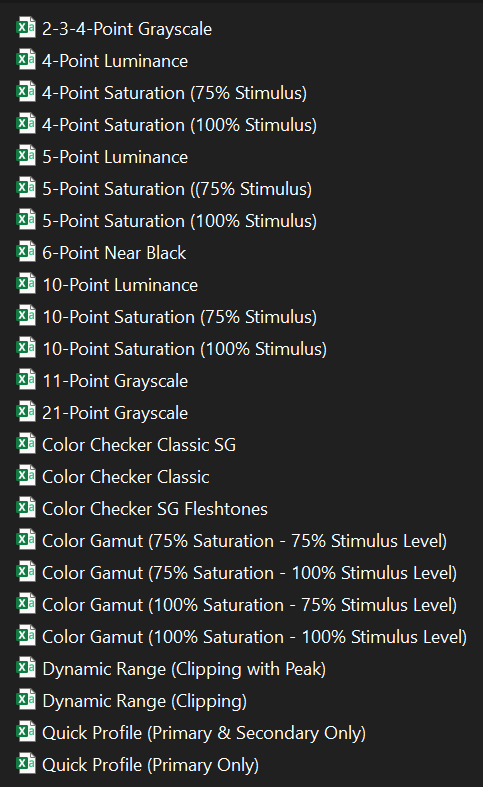
The saturation patchsets are different from those included in ColourSpace. (ZRO does not include any patchlist)
ColourSpace uses equal-spaced RGB for saturation steps.
The equal-spaced RGB values will not map as equal-spaced points in a CIE chromaticity diagram.
Ted's saturation patchsets use trigonometry to calculate the RGB targets, like CalMAN, so the calibration targets between ColourSpace and CalMAN will match in the CIE chromaticity diagram.
Ted's RGB triplets match CalMAN's RGB triplets on those patchlists.
You can use them to compare different meter settings between ColourSpace and CalMAN.
You can evaluate the measuring speed or the repeatability in low-luminance levels.
PGenerator with Pi4 and ColourSpace/ColourSpaceZRO provides 'real' 10-bit (SDR/HDR10/HLG) and Dolby Vision patch generation.
These TPG options were previously available only to expensive license levels and hardware TPGs.
You can purchase Ted's PGenerator as a bundle with ColourSpaceZRO for -5$ less.

This website uses a Comodo Positive SSL certificate to protect online transactions with the highest strength encryption.
